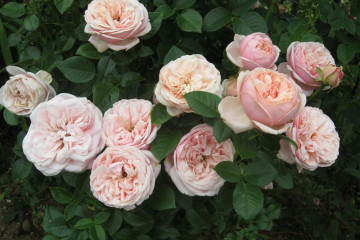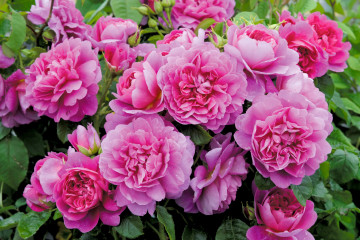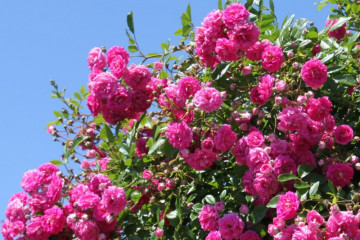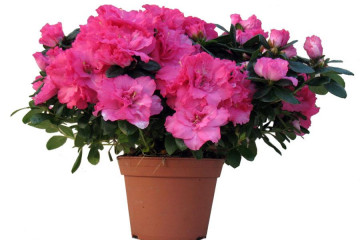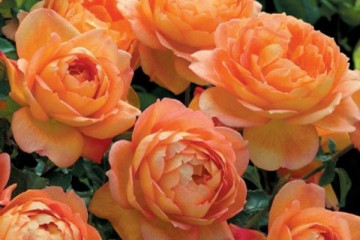Rose Rococo (Rokoko) - description of the variety and and its varieties
Content:
The Rococo shrub rose captivates with its delicate beauty. Powerful shoots, endurance and unpretentiousness of the plant, combined with an intricate apricot color - all this makes the variety in demand and popular among flower growers. Rococo is at the forefront of cutting varieties, and its lush flowering shrubs add a special charm to any flower bed.
Description and characteristics of the Rococo rose
Rose scrub Rococo belongs to varieties of medium growth - the plant reaches a height of 120 to 150 cm. It was bred at the end of the last century, it is distinguished by abundant and long flowering and the ability to bloom again.
A special charm and nobility to the Rococo climbing rose bushes is given by their shape: with rather tall shoots, they do not grow wider than 1 m.Strong branches rush up and create a dense crown that looks massive and impressive both in a hedge and in single plantings.
Shoots grow quickly, becoming thick and strong when ripe. The leaves are dark, glossy, muted in tone, therefore, against their background, watercolor flowers resembling ancient varieties look especially bright and elegant.
Large flowers of the variety are collected in a brush and bloom for about two weeks. The buds are small, yellow in color with a pink sharp top. When they bloom, the doubleness and slight waviness of the petals are clearly visible. When the flower is fully opened, bright orange stamens are visible.
The color of the Rococo bush rose flowers presents transitions from light apricot to pink shades. After full flowering, it becomes creamy, and by the time of wilting, it fades more and more.
Advantages and disadvantages of the variety
The undoubted advantages of the Rococo variety include:
- good drought tolerance;
- long flowering period;
- frost resistance;
- exquisite appearance;
- doubleness and large size of the flower;
- disease and pest resistance;
- re-flowering.
At the same time, the disadvantages of the plant are completely insignificant:
- requires spacious areas and bright sun during the day;
- does not have a strong aroma.
Popular varieties of the Rococo variety
Among the most popular varieties of varieties, special attention deserves:
- Lovely Rokoko. It is a shrub of about 1 m with double large flowers and good immunity to powdery mildew and black spot. It blooms again and until frost.
- Magic Rokoko. A hybrid tea variety with powerful and abundant shoots. Large large flowers form large inflorescences.
- Lemon Rokoko. Large double flowers of the variety at the beginning of flowering have a greenish tint. They are not afraid of rain and keep fresh for a long time in a vase after cutting.
- Playful Rokoko rose variety. Differs in double pink flowers that look very impressive in a bouquet. Therefore, the variety is often bred for cutting.
Flower growing rules
In order to get a luxurious and healthy plant, do not neglect the basic recommendations of experienced florists.
The quality and duration of the flowering period completely depends on the choice of a place for planting rose bushes of this variety. The plant does not accept even light partial shade. Only sunny places open to direct rays. Moreover, the longer the plant is illuminated during the day, the more abundantly and magnificently it can bloom.
The requirements for the soil of the Rococo rose variety are the same as for most other roses: it must be light, nutritious, well-drained to avoid stagnant water. It is desirable that these were loams or sandy loam.
The description of the planting process is as follows:
- The site allocated for planting is dug deeply and thoroughly.
- Prepare planting holes depending on the size of the roots of the bush.
- If the quality of the soil requires it, drainage material is applied to the bottom of the pit.
- Shoots prepared for planting are cut, leaving 10-15 cm.
- If a seedling with an open root system is planted, it is soaked for several hours in water. Plants transplanted from containers are watered thoroughly.
- Place the seedlings in the holes and carefully cover their roots with soil mixed with compost.
- The soil is lightly tamped and thoroughly watered.
You can plant a Rococo rose in this way both in spring and autumn. However, if the climatic conditions in winter are too harsh, then it is better not to risk it with an autumn planting.
Plant care rules
Rose Rococo does not require too close attention to itself, you just need to adhere to simple rules:
- Watering and humidity. The variety needs watering only in the absence of natural precipitation and with a strong drying out of the earthen coma. Watering in this case should be abundant.
- Top dressing. For abundant flowering, it is important to fertilize in the first half of summer: the first time - at the beginning of the growing season in spring, the second time - before flowering. Special mineral complexes are used for roses. Organic fertilizers can also be used.
- Pruning. This procedure allows you to give the plant its original shape. In the spring, you need to remove all twisted, dry shoots growing deep into the crown at the root. Healthy branches should be cut by one third.
- Mulching. The use of mulch helps to retain moisture and keep the plant's root system from overheating. Therefore, the mulching layer needs to be renewed several times during the season.
- Preparing for winter. Before the onset of cold weather, you need to remove all dried shoots and fallen leaves, which may contain the larvae of various pests. If there is a high probability of a winter with little snow with frequent thaws, it is better to cover the rose bushes. For this purpose, the plant is spud with compost, and the shoots are covered with spruce branches.
Flowering and resting period
Rokoko is a rose that blooms in early summer. But at the same time, its bushes are strewn with flowers until the first frost, as the plant constantly throws out more and more new buds.
Flowers are not afraid of rain, and after a long stay in the sun, although they fade, they do not lose their decorative effect.
Flower reproduction methods
Most often, cuttings are used to propagate Rococo roses. This method is quite simple to implement and gives good results.
In the middle of summer, cuttings are cut from healthy shoots and rooted in a wet substrate or sand. To speed up the process, greenhouse conditions are created for the cutting by covering it with plastic or glassware.
After rooting, the young plant is planted in a permanent place of growth.
Possible diseases and pests, ways to deal with them
The Rococo rose variety shows good resistance to many common diseases. Stem cancer is a dangerous disease for the plant. When damaged, bright red spots appear on the shoots of the rose, which fade, but spread throughout the plant. The only way out in this situation is the immediate removal of the diseased bush.
Among the pests sometimes found on shoots, spider mites and aphids should be noted. You can try to get rid of them using folk methods. In case of severe damage, insecticide treatment is used.
Rococo rose is a colorful, medium-sized scrub with dense dark foliage and large flowers of a delicate apricot shade with a transition to pink. The variety is distinguished by unpretentious care and a long flowering period. In addition, the plant has a stable immunity to many diseases. The main condition for lush and long flowering is planting in spacious areas of the garden, which are illuminated by the sun during the day.






